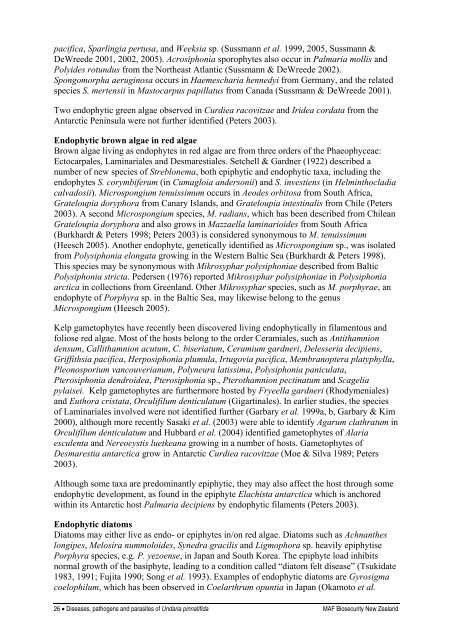Diseases, pathogens and parasites of Undaria pinnatifida
Diseases, pathogens and parasites of Undaria pinnatifida
Diseases, pathogens and parasites of Undaria pinnatifida
You also want an ePaper? Increase the reach of your titles
YUMPU automatically turns print PDFs into web optimized ePapers that Google loves.
pacifica, Sparlingia pertusa, <strong>and</strong> Weeksia sp. (Sussmann et al. 1999, 2005, Sussmann &<br />
DeWreede 2001, 2002, 2005). Acrosiphonia sporophytes also occur in Palmaria mollis <strong>and</strong><br />
Polyides rotundus from the Northeast Atlantic (Sussmann & DeWreede 2002).<br />
Spongomorpha aeruginosa occurs in Haemescharia hennedyi from Germany, <strong>and</strong> the related<br />
species S. mertensii in Mastocarpus papillatus from Canada (Sussmann & DeWreede 2001).<br />
Two endophytic green algae observed in Curdiea racovitzae <strong>and</strong> Iridea cordata from the<br />
Antarctic Peninsula were not further identified (Peters 2003).<br />
Endophytic brown algae in red algae<br />
Brown algae living as endophytes in red algae are from three orders <strong>of</strong> the Phaeophyceae:<br />
Ectocarpales, Laminariales <strong>and</strong> Desmarestiales. Setchell & Gardner (1922) described a<br />
number <strong>of</strong> new species <strong>of</strong> Streblonema, both epiphytic <strong>and</strong> endophytic taxa, including the<br />
endophytes S. corymbiferum (in Cumagloia <strong>and</strong>ersonii) <strong>and</strong> S. investiens (in Helminthocladia<br />
calvadosii). Microspongium tenuissimum occurs in Aeodes orbitosa from South Africa,<br />
Grateloupia doryphora from Canary Isl<strong>and</strong>s, <strong>and</strong> Grateloupia intestinalis from Chile (Peters<br />
2003). A second Microspongium species, M. radians, which has been described from Chilean<br />
Grateloupia doryphora <strong>and</strong> also grows in Mazzaella laminarioides from South Africa<br />
(Burkhardt & Peters 1998; Peters 2003) is considered synonymous to M. tenuissimum<br />
(Heesch 2005). Another endophyte, genetically identified as Microspongium sp., was isolated<br />
from Polysiphonia elongata growing in the Western Baltic Sea (Burkhardt & Peters 1998).<br />
This species may be synonymous with Mikrosyphar polysiphoniae described from Baltic<br />
Polysiphonia stricta. Pedersen (1976) reported Mikrosyphar polysiphoniae in Polysiphonia<br />
arctica in collections from Greenl<strong>and</strong>. Other Mikrosyphar species, such as M. porphyrae, an<br />
endophyte <strong>of</strong> Porphyra sp. in the Baltic Sea, may likewise belong to the genus<br />
Microspongium (Heesch 2005).<br />
Kelp gametophytes have recently been discovered living endophytically in filamentous <strong>and</strong><br />
foliose red algae. Most <strong>of</strong> the hosts belong to the order Ceramiales, such as Antithamnion<br />
densum, Callithamnion acutum, C. biseriatum, Ceramium gardneri, Delesseria decipiens,<br />
Griffithsia pacifica, Herposiphonia plumula, Irtugovia pacifica, Membranoptera platyphylla,<br />
Pleonosporium vancouverianum, Polyneura latissima, Polysiphonia paniculata,<br />
Pterosiphonia dendroidea, Pterosiphonia sp., Pterothamnion pectinatum <strong>and</strong> Scagelia<br />
pylaisei. Kelp gametophytes are furthermore hosted by Fryeella gardneri (Rhodymeniales)<br />
<strong>and</strong> Euthora cristata, Orculifilum denticulatum (Gigartinales). In earlier studies, the species<br />
<strong>of</strong> Laminariales involved were not identified further (Garbary et al. 1999a, b, Garbary & Kim<br />
2000), although more recently Sasaki et al. (2003) were able to identify Agarum clathratum in<br />
Orculifilum denticulatum <strong>and</strong> Hubbard et al. (2004) identified gametophytes <strong>of</strong> Alaria<br />
esculenta <strong>and</strong> Nereocystis luetkeana growing in a number <strong>of</strong> hosts. Gametophytes <strong>of</strong><br />
Desmarestia antarctica grow in Antarctic Curdiea racovitzae (Moe & Silva 1989; Peters<br />
2003).<br />
Although some taxa are predominantly epiphytic, they may also affect the host through some<br />
endophytic development, as found in the epiphyte Elachista antarctica which is anchored<br />
within its Antarctic host Palmaria decipiens by endophytic filaments (Peters 2003).<br />
Endophytic diatoms<br />
Diatoms may either live as endo- or epiphytes in/on red algae. Diatoms such as Achnanthes<br />
longipes, Melosira nummoloides, Synedra gracilis <strong>and</strong> Ligmophora sp. heavily epiphytise<br />
Porphyra species, e.g. P. yezoense, in Japan <strong>and</strong> South Korea. The epiphyte load inhibits<br />
normal growth <strong>of</strong> the basiphyte, leading to a condition called “diatom felt disease” (Tsukidate<br />
1983, 1991; Fujita 1990; Song et al. 1993). Examples <strong>of</strong> endophytic diatoms are Gyrosigma<br />
coelophilum, which has been observed in Coelarthrum opuntia in Japan (Okamoto et al.<br />
26 • <strong>Diseases</strong>, <strong>pathogens</strong> <strong>and</strong> <strong>parasites</strong> <strong>of</strong> <strong>Undaria</strong> <strong>pinnatifida</strong> MAF Biosecurity New Zeal<strong>and</strong>

















